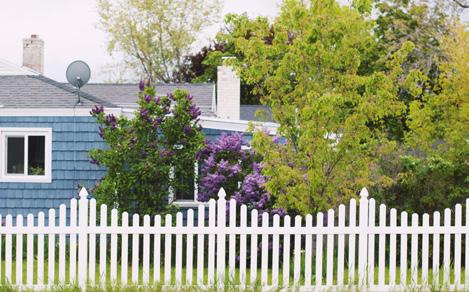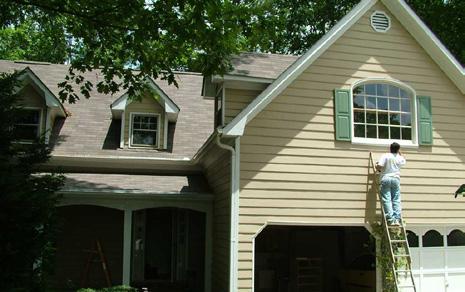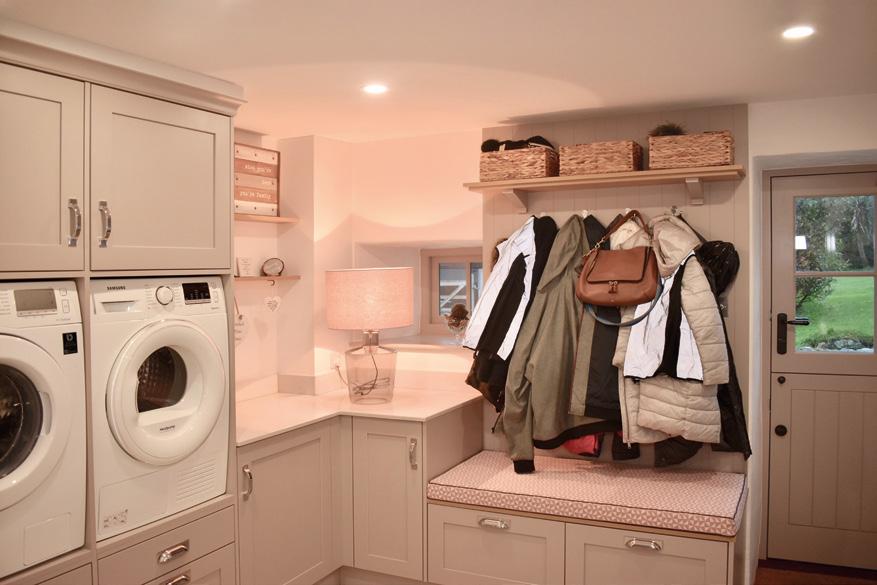
10 minute read
Spring Jobs
SPRING IS ON THE WAY
After a long, cold winter, which has seen more of us working from home than ever before, it’s a comforting feeling to see the first signs of warmer times. For many homeowners, this is a time to freshen up their property with either a deep clean or a spot of DIY.
Advertisement
If you’re one of the many who plan to embark on some home improvements this spring, here are a few tips.

CHECKING THE PIPES
The cold winter months can cause damage and blockages within pipes and as the weather thaws it’s important to check everything is still in working order. It can be relatively cheap to pick up pipe cleaning kits and solutions but it can be worth it to have them professionally cleaned too. Even the most basic of blockage removals can cost as much as £100 and the cost of a brand new system can spiral even further.

THE ROOF
Much like a fence, a little damage to the roof can be quick and inexpensive to repair. A minor roof repair now is far better than leaving it to let the damage spread – which could end up costing thousands in the long run.

FENCING
Fencing can often take a battering during the winter, particularly with the strong winds seen around our shores. Fence panels can cost as little as £20 apiece, with posts coming in at around the same price, so if you have a hole in your fence it pays to fix it quickly. The longer you leave it the more likely it is that the damage will spread due to the weak link, and replacing a whole fence can cost a substantial amount.

GUTTERS AND DOWNPIPES
These are easily damaged or blocked when the weather is poor and leaves are falling from the trees. Having them cleaned professionally is a good shout and costs as little as £5 a metre. Leave it until the damage is done and you’re looking at the cost of a replacement gutter or a new downpipe, which can soon spiral into hundreds of pounds.

PATIO AND DECKING
Patio and decking is usually pretty durable stuff but it still needs some TLC. Cleaning materials can cost as little as £15 or you can spend a few hundred pounds to either hire a professional cleaner or buy your own machine. Power washing is one of those rewarding jobs you can do yourself and see instant results.

PAINT PROTECTION
It doesn’t matter if you’re talking about the inside or outside of your home, paint is your property’s first line of defence against the elements and the rigours of day to day life. Cracks may seem like a small problem but they soon spread, causing the paint to flake and leaving the soft underbelly of your home exposed.
Keeping on top of the job yourself can mean forking out for paint and materials for as little as £35. Having to hire a professional because your home has past the point of DIY return could cost you substantially more.

BRICKWORK
Brickwork is your primary defence against the seasons and, just like your roof, it can take a battering during the winter. The freeze and thaw process can cause the pointing between bricks to degrade and this can cause major problems if left ignored.
In this instance, it’s best to get the help of a professional. Leave it until the whole house is in need and you’re facing a bill that can run into thousands.

THE GARDEN
Last but not least, the garden is another area that can get woefully neglected over the winter months. It can seem a mammoth task but rolling up your sleeves with £50 worth of maintenance materials is far cheaper than leaving it until it requires a professional gardener.
With these tips, you should find a good balance between DIY jobs you can handle yourself and the smaller jobs that require a bit of budget for a skilled tradesperson. But by keeping on top of them and catching them in the early stages, you’ll end up spending a few hundred pounds, rather than thousands.
TIME FOR A NEW KITCHEN?
CUTTING BACK AND MULCHING
Sandra Robinson knows a thing or two about kitchens and bedrooms. Here she tells us more about why spring is the perfect time to take that next step.
Jack Etheridge of Auburn Gardens give us some tips on what we should be doing in the garden right now.
Starting your new kitchen or bedroom renovation can be a very daunting prospect and it’s not always easy to know where to start. After 27 years designing kitchens and bedrooms, I have witnessed tremendous change and evolution and there is now a vast amount of choice available to the client. With social media platforms like Houzz & Pinterest for inspiration, they demonstrate that anything is possible.
I believe that you shouldn’t have to compromise when it comes to your perfect kitchen. It has become the heart of the home, the hub of family life and main social space, so I believe in open consultations between clients and my experienced designers to hit that balance of wow factor & practicality.
With spring just around the corner, the two tasks that we prioritise this time of year are cutting back ornamental grasses and any perennials you may have missed in autumn.
I’m a big fan of refraining from ‘deadheading’ everything, I like to leave spent seed pods on certain plants during the winter if they look interesting. However, around February, after a few months of being bashed and beaten by the cold Atlantic winds, the time does finally come to get the secateurs out. Of course, for more prolific growth, cutting back is necessary to make room for fresh shoots come spring time.
Ornamental grasses fall into two main groups, deciduous - they die back over winter, or evergreen - colour year-round. Evergreens generally just require a tidy up and a comb over (yes, you can actually use a comb, my grandad did!). As we move from the new year into spring, there is never a better time to take the plunge and start the ball rolling. With the assistance of our main British supplier, ‘Masterclass’, our company offers an online wish list to ensure that all of the basics are thought about and considered from the start. Full 3-Dimensional software is utilised to help and inspire, bringing the kitchen to life before a brick has been laid or a penny spent. Virtual Reality can transport you to how the future can look in your home.
Our Town showroom has many displays showing kitchen design features to suit every lifestyle. You are in safe hands when it comes to choosing from the variety of combinations that bring together colour, texture and design elements in ways that will set your kitchen apart, moving from classic Shaker to modern handless minimalist style with a choice of colour palette to enhance your lifestyle.
We’re passionate about design and can’t wait to hear from you.
To cut back deciduous grasses, choose a sharp pair of secateurs or scissors, grasp top growth and cut around 5-10cm off the ground. Don’t cut back as hard if there is a lot of fresh green growth; however, a few bits trimmed here and there won’t hurt. Similarly with perennials, cut down to ground level and close to a node or new bud with a slanting cut.
Once finished, you may be in a state of shock. Don’t worry. Your previously full, although slightly messy border, now may look a little barren, but fear not, it’s very beneficial and this hard work will result in much fuller, healthier plants in the summer.
Now the ground is exposed, it is a lot easier to get some lovely mulch on the soil to improve its structure and add nutrients. Mulching in this context requires a good layer of compost or rotted down organic material such as horse manure. You don’t have to do this every year, but it’s a good idea to mulch every two to three years. Always try to buy local, there are a few commercial producers making gorgeous compost here, not only is it kinder on the environment, you will be supporting local artisans doing great things in the community.





Why should I be an architect?
Paul Langlois BA, DipArch, RIBA, tells us why architecture could be the career for you.
GUERNSEY SOCIETY of ARCHITECTS
For further information go to: www.ribaarchitecture.com/education I’m often asked, ‘Why should I become an architect?’ Looking back over 30 years of practice I can reflect on the pros and cons of the career. Architecture is at an exciting transition phase due to advances in design, construction and environmental issues. The public is now more aware through the plethora of TV programs, magazines and the ubiquitous Pinterest.
So here are the main aspects of an architectural career:
Education
“Seven years to become a qualified architect?! That’s a long time.”
Yes, but it’s broken into a three-year degree, two-year diploma and two years in practice. UK architectural schools are respected throughout the world and so are their students.
It is an interesting wide-ranging course teaching design through to psychology. You can do the degree then decide whether to diversify. I have known architectural students become lighting designers and even the Lord Mayor of the City of London!
The work environment
Architecture is a transportable career and architectural practices are a rich mix of people with diverse backgrounds and interests. There is a commonality in the interest of architecture and also sports and culture so they tend to be very social places.
Shaping lives
Clients come to you to help them enhance their environment. It could be a first-time buyer or a new school which will impact on many peoples’ lives. An architect has the skill set to facilitate this to realise ambitions, improve lives and provide a lasting legacy.
Creativity
Every project is a conundrum to be solved. You start off with a blank piece of paper and look for sources of inspiration, thinking ‘outside the box’ to resolve the ‘puzzle’. I like being in a profession where there are people to admire for what they have created.
Teamwork
An architect works alongside clients, consultants, contractors and specialists. Each person has a role to play to create a building. Good communication skills are essential.

Variety of roles
Few architects purely sketch designs for others to draw up. Architects may specialise in specific roles that suit their interest; however, most are trained to have a broad knowledge of the whole design and construction process from start to finish.
Variety of work
There is variety, especially in Guernsey, where you can work on a 15th century farmhouse in the morning and a 21st century new build in the afternoon! There is satisfaction to be found when working on individual and unique, finite projects each requiring different skillsets.
Environmental issues
I once asked a joiner about using an African hardwood, ‘Is it from a sustainable source?’ and he replied, ‘Well we don’t have any trouble getting hold of it!’
Everyone is now more aware of the need to design sustainably. Advances in ‘smart’ and passive design require architects to keep abreast of the latest technology.
Presentation
In 1983 a computer lecturer told us, ‘In 15 years time there’ll be no drawings boards in architectural offices, just computers.’ We laughed at the thought, however he was right.
The advancement of CAD and 3-D representations has been exciting in transforming how architects design, freeing up the process.
Work/life balance
It is a demanding, intensive job, with many hours spent in the office working out a design, but then maybe you have a ‘Eureka!’ moment in the middle of the night.
Working long hours begins at university where the ‘all-nighter’ becomes a badge of honour amongst your fellow students. It’s all part of the close social bonding that exists between architectural students!








